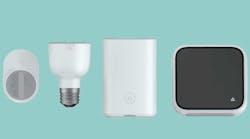Secure Wi-Fi 6 Plus Bluetooth LE SoC is Matter-Ready
Silicon Labs announced a secure ultra-low-power Wi-Fi 6 and Bluetooth LE wireless SoC family, as it looks to win over customers with a host of hardware and software tools tailored for the Internet of Things (IoT).
At its annual Works With developer conference, the company said the SiWx917 will support the new Matter smart-home standard that promises to usher in the future of the IoT era. The announcement is another step in its effort to become a top-tier supplier in the hotly contested IoT market, offering a full complement of wireless chips that help reduce development costs, slash time-to-market, and future-proof IoT devices.
It's an ambitious goal. But CEO Matt Johnson believes everything is falling into place for Silicon Labs to win the wireless IoT market—from hardware to software, security, customer support, and development tools.
Since stepping away from markets outside the IoT, Silicon Labs said its remaining business has doubled. “We’re here supporting multiple protocols and ecosystems,” said the CEO. “No company is better focused.”
He compared the company’s IoT strategy to NVIDIA’s approach to artificial intelligence in recent years. “We see that potential for ourselves in the IoT,” he said on a conference call with reporters and analysts last week.
Why Matter Matters
He said one of the biggest boosts for the new era of IoT will come from the Matter standard. It is designed as a unifying application layer that will bridge gaps between rival ecosystems emerging in the smart home.
IoT devices use a wide range of different radio communications protocols. Matter is an open connectivity standard created by more than 200 companies, including Amazon, Apple, Google, and Samsung. It taps into existing wireless technologies—Thread, Wi-Fi, Bluetooth, Zigbee, and others—to enable everything from smart thermostats or lights you control with a smartphone to connect to each other no matter the vendor.
The final Matter specification should be available by the end of 2022. Silicon Labs said it plans to roll out the first product in the single-chip Matter-ready SoC family by mid-2023.
According to the company, its IoT-related portfolio gives its customers the flexibility to support Matter over Wi-Fi, Thread, Bluetooth, and other smart-home wireless standards like Zigbee and Z-Wave.
So, whatever wireless protocol customers want to use, it offers hardware, software, and development tools that give them the ability to bridge their products to Matter and connect to all major smart-home ecosystems.
What’s Inside Matters
At the heart of the SiWx917 is a quad-thread wireless networking subsystem based on Silicon Labs’ ThreadArch running at 160 MHz. Also included is a rich suite of analog and digital peripherals and host interfaces.
The chip contains a single-band 2.4-GHz Wi-Fi radio as well as a Bluetooth Low Energy (BLE) 5.1 radio that supports data rates of 1 Mb/s and 2 Mb/s and long-range transmission modes that transfer up to 125 kb/s and 500 kb/s.
The SiWx917 also incorporates a 180-MHz Arm Cortex-M4 MCU with FPU. It is supplemented with a machine-learning engine to handle on-device AI and a power-management subsystem to help prolong battery life. On top of that, there's up to 672 kB of embedded SRAM and up to 8 MB of flash, giving it enough memory to run wireless stacks and even to accommodate upgrades in the future. Additional PSRAM can be attached.
Everything fits inside a single-chip solution that the company touts as up to 50% more energy-efficient than rival offerings. Thus, it’s ideal for energy-efficient and battery-powered devices with always-on connectivity to the cloud.
Silicon Labs integrated its PSA-L2 certifiable “secure vault” subsystem into the SiWx917 to defend IoT devices from hackers. The security engine includes a secure zone and a separate trusted execution environment (TEE), plus secure boot, a root of trust (RoT), and advanced cryptographic accelerators. It can also run execute-in-place (XIP) to run code directly from serial flash without copying the code to the RAM.
“Security is elemental, it is foundational in the IoT space,” said Johnson. He added that while it has taken a long time for many electronics companies to start taking IoT security seriously, they have come around. He pointed out that now “there is very little debate about the importance of security, and we believe there is no future for the IoT without security becoming integral."
Everything in the single Matter-ready chip comes packed in a 7- × 7-mm QFN package.
Software Matters, Too
Another important way Silicon Labs is trying to accelerate IoT development is with a host of hardware and software that will serve as end-to-end Matter development kits for all ecosystems and wireless protocols.
Last year, Silicon Labs introduced its Unify SDK, a multi-protocol software development kit for Matter-based routers. The software tool supports protocol-specific translations between all of the different wireless IoT protocols, including Zigbee and Z-Wave, used in the smart home. That way, customers can avoid a situation where a product will no longer function if a wireless standard falls out of favor.
Silicon Labs said customers can choose to develop IoT devices using the Unify SDK for existing wireless protocols, then later leverage it to activate Matter when it makes sense or to add support for new wireless protocols. For the first time, customers will be able to develop and maintain a single software code base for IoT devices, including gateways, and add wireless protocol support when necessary, said Silicon Labs.
The company also said that its Simplicity Studio and Gecko SDK will give its customers a unified development platform to enable Matter on consumer devices and then attach those devices to the appropriate ecosystem.
Silicon Labs is not the only firm trying to lure IoT companies over to its side before Matter becomes the standard way for smart homes to communicate. At the start of the year, NXP Semiconductors rolled out a secure Matter-ready radio SoC that integrates three of the leading connectivity radios—Wi-Fi 6, Bluetooth 5.2, and the 802.15.4 standard for Thread and Zigbee—in a single chip for the first time.
The SiWx917 from Silicon Labs is sampling, with general availability anticipated in the second half of 2023.


